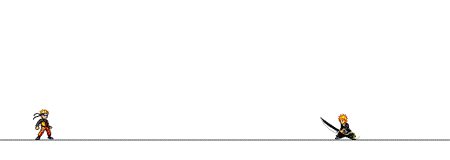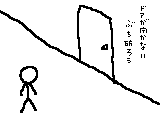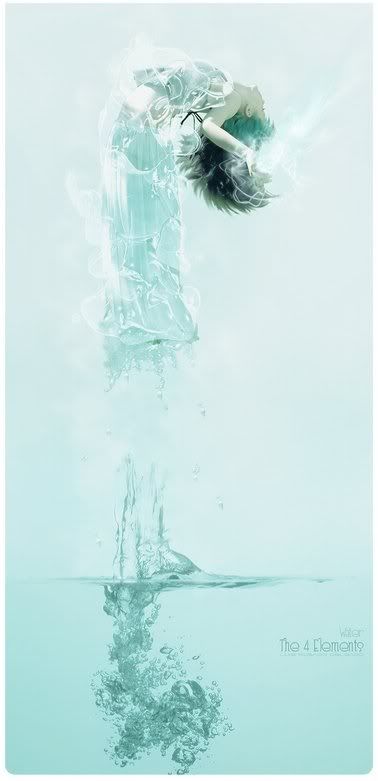Showing posts with label Treasures. Show all posts
Showing posts with label Treasures. Show all posts
Friday, September 14, 2012
Wednesday, August 29, 2012
Wednesday, September 28, 2011
Treasure hunters eye huge silver haul from WWII ship
Source from AFP News :
When the SS Gairsoppa was torpedoed by a German U-boat 70 years ago, it took its huge silver cargo to a watery grave. US divers are working to recover what may be the biggest shipwreck haul ever, valued at some $210 million.
Florida-based Odyssey Marine Exploration on Monday confirmed the identity and location of the Gairsoppa, and cited official documents indicating the British ship was carrying some 219 tons of silver when it sank in 1941 in the North Atlantic some 300 miles (490 kilometers) off the Irish coast.
Valued then at 600,000 pounds, the silver today is worth about $210 million, which would make it history's largest recovery of precious metals lost at sea, Odyssey said.
"We've accomplished the first phase of this project -- the location and identification of the target shipwreck -- and now we're hard at work planning for the recovery phase," Odyssey senior project manager Andrew Craig said in a statement.
"Given the orientation and condition of the shipwreck, we are extremely confident that our planned salvage operation will be well suited for the recovery of this silver cargo."
Recovery is expected to begin next spring.
After a competitive tender process the British government awarded Odyssey an exclusive salvage contract for the cargo, and under the agreement Odyssey will retain 80 percent of the silver bullion salvaged from the wreck.
The 412-foot (125-meter) Gairsoppa had been sailing from India back to Britain in February 1941 bearing a cargo of silver, pig iron and tea, and was in a convoy of ships when a storm hit. Running low on fuel, the Gairsoppa broke off from the convoy and set a course for Galway, Ireland.
It never made it, succumbing to a German torpedo in the contested waters of the North Atlantic. Of the 85 people on board, only one survived.
The Gairsoppa came to rest nearly 15,400 feet (4,700 meters) below the surface, where for decades it was lost to the world. A previous effort to locate the shipwreck failed.
Odyssey found it relatively quickly, and insists the depth of the site won't prevent a full cargo recovery.
"We were fortunate to find the shipwreck sitting upright, with the holds open and easily accessible," Odyssey chief executive Greg Stemm said.
"This should enable us to unload cargo through the hatches as would happen with a floating ship alongside a cargo terminal."
Odyssey is a world leader in deep-ocean exploration and has numerous shipwreck hunting projects in process around the globe.
In May 2007, it announced it had found half a million silver coins and hundreds of gold objects from a ship they code-named the "Black Swan," which went down in 1804 in the Atlantic off the Strait of Gibraltar. The find is being contested by Spain, which claims the trove.
In the latest operation, the firm recently conducted remotely operated vehicles from its main ship, the Odyssey Explorer, to inspect the Gairsoppa wreck. It acquired still and video imagery from the site which were used to confirm the identify and evaluate the condition of the ship.
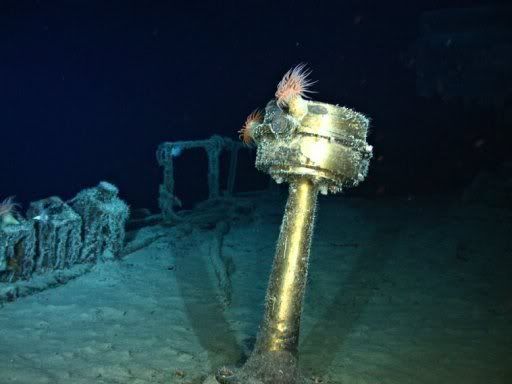
~ Handout image courtesy of the Odyssey Marine Exploration shows a stern compass of the SS Gairsoppa on the top of the poop deck
Photographs released by the company show clear details of the Gairsoppa, including a ladder leading to the forecastle deck, a waist-high compass used by the helmsman, even the hole in the steel hull blown open by the torpedo.

~ Graphic on the last voyage of the SS Gairsoppa, torpedoed by a German U-boat in World War II, carrying 219 tons of silver. Florida-based company Odyssey Marine Exploration is working to recover the treasures.
The find highlights the influential role that modern technology has come to play in the business of finding shipwrecks, with vastly improved sonar equipment, global positioning systems and advanced deepwater robots that scour the world's oceans for booty.
UNESCO estimates there are some three million shipwrecks worldwide, with billions of dollars in sunken treasures and priceless knowledge that can be recovered from the depths of the ocean, including vast amounts of naturally occurring copper, silver, gold and zinc deposits waiting to be discovered
"The majority of the world's ocean floor has not yet been explored," said Odyssey president Mark Gordon, who told AFP that the discovery at some 4,700 meters (15,400 feet) beneath below the ocean's surface is a treasure trove for companies like his.
"We know more about the surface of the moon than we know about the deepest parts of the oceans. It's exciting to be working at depths like these and to be among the pioneers of deep ocean exploration in this unexplored frontier."
When the SS Gairsoppa was torpedoed by a German U-boat 70 years ago, it took its huge silver cargo to a watery grave. US divers are working to recover what may be the biggest shipwreck haul ever, valued at some $210 million.
Florida-based Odyssey Marine Exploration on Monday confirmed the identity and location of the Gairsoppa, and cited official documents indicating the British ship was carrying some 219 tons of silver when it sank in 1941 in the North Atlantic some 300 miles (490 kilometers) off the Irish coast.
Valued then at 600,000 pounds, the silver today is worth about $210 million, which would make it history's largest recovery of precious metals lost at sea, Odyssey said.
"We've accomplished the first phase of this project -- the location and identification of the target shipwreck -- and now we're hard at work planning for the recovery phase," Odyssey senior project manager Andrew Craig said in a statement.
"Given the orientation and condition of the shipwreck, we are extremely confident that our planned salvage operation will be well suited for the recovery of this silver cargo."
Recovery is expected to begin next spring.
After a competitive tender process the British government awarded Odyssey an exclusive salvage contract for the cargo, and under the agreement Odyssey will retain 80 percent of the silver bullion salvaged from the wreck.
The 412-foot (125-meter) Gairsoppa had been sailing from India back to Britain in February 1941 bearing a cargo of silver, pig iron and tea, and was in a convoy of ships when a storm hit. Running low on fuel, the Gairsoppa broke off from the convoy and set a course for Galway, Ireland.
It never made it, succumbing to a German torpedo in the contested waters of the North Atlantic. Of the 85 people on board, only one survived.
The Gairsoppa came to rest nearly 15,400 feet (4,700 meters) below the surface, where for decades it was lost to the world. A previous effort to locate the shipwreck failed.
Odyssey found it relatively quickly, and insists the depth of the site won't prevent a full cargo recovery.
"We were fortunate to find the shipwreck sitting upright, with the holds open and easily accessible," Odyssey chief executive Greg Stemm said.
"This should enable us to unload cargo through the hatches as would happen with a floating ship alongside a cargo terminal."
Odyssey is a world leader in deep-ocean exploration and has numerous shipwreck hunting projects in process around the globe.
In May 2007, it announced it had found half a million silver coins and hundreds of gold objects from a ship they code-named the "Black Swan," which went down in 1804 in the Atlantic off the Strait of Gibraltar. The find is being contested by Spain, which claims the trove.
In the latest operation, the firm recently conducted remotely operated vehicles from its main ship, the Odyssey Explorer, to inspect the Gairsoppa wreck. It acquired still and video imagery from the site which were used to confirm the identify and evaluate the condition of the ship.

~ Handout image courtesy of the Odyssey Marine Exploration shows a stern compass of the SS Gairsoppa on the top of the poop deck
Photographs released by the company show clear details of the Gairsoppa, including a ladder leading to the forecastle deck, a waist-high compass used by the helmsman, even the hole in the steel hull blown open by the torpedo.

~ Graphic on the last voyage of the SS Gairsoppa, torpedoed by a German U-boat in World War II, carrying 219 tons of silver. Florida-based company Odyssey Marine Exploration is working to recover the treasures.
The find highlights the influential role that modern technology has come to play in the business of finding shipwrecks, with vastly improved sonar equipment, global positioning systems and advanced deepwater robots that scour the world's oceans for booty.
UNESCO estimates there are some three million shipwrecks worldwide, with billions of dollars in sunken treasures and priceless knowledge that can be recovered from the depths of the ocean, including vast amounts of naturally occurring copper, silver, gold and zinc deposits waiting to be discovered
"The majority of the world's ocean floor has not yet been explored," said Odyssey president Mark Gordon, who told AFP that the discovery at some 4,700 meters (15,400 feet) beneath below the ocean's surface is a treasure trove for companies like his.
"We know more about the surface of the moon than we know about the deepest parts of the oceans. It's exciting to be working at depths like these and to be among the pioneers of deep ocean exploration in this unexplored frontier."
Thursday, February 17, 2011
Swiss Watch Found in 400-Year Old Chinese Tomb
While some mysteries are occasionally solved, the majority tend to live on forever without the truth being revealed. One in the latter category concerns the recent discovery of a century-old Swiss watch discovered in an ancient Chinese tomb that has been sealed for more than 400 years.
How did it get there? This is the question haunting the archaeologists who discovered the Swiss watch in an ancient tomb in Shangsi, southern China, they believed had not been opened since its occupant’s funeral, which occurred during the Ming Dynasty (15-16th centuries).They believed they were the first to visit the Ming dynasty grave in Shangsi, southern China, since its occupant's funeral. The Ming Dynasty - or the Empire of the Great Ming - was the was ruling dynasty in China from 1368 to 1644.
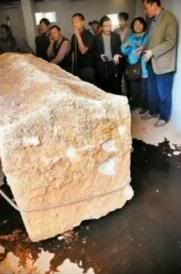
The miniature watch, which is in the shape of a ring, is thought to be barely a century old. The mysterious timepiece was encrusted in mud and rock and had stopped at 10:06 am. On the back of the watch, the word, ‘Swiss’ is engraved.
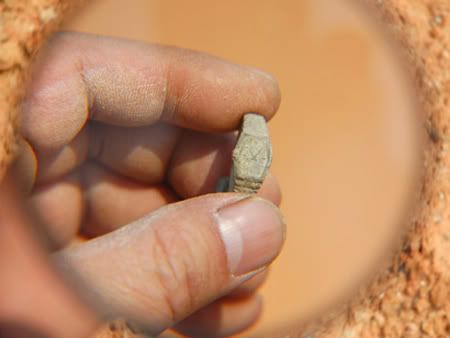
Its presence raises more questions than answers… like: Where did the watch come from? Could the watch/ring have been planted at the tomb, but if so, why and by whom?
The known facts do not really help in this case.
The Ming Dynasty did have its own unique age of watch making, but that does not explain why the word, 'Swiss’ on the back of the watch is engraved in English. In Geneva, Switzerland, other languages were more common, namely French and German.
In 1541 in Geneva, there was a ban on flashy jewelry, so the idea of a watch/ ring might make some sense, as a watch was considered practical and essential. Still, there is no record anywhere of ring/watches being popular in Europe until after 1780, which only deepens the mystery.
The dig has been suspended and researchers are currently awaiting the arrival of some experts from Beijing to help them unravel this most unsettling mystery.
Anyone know what time it is?
Watches were not around at the time of the Ming Dynasty and Switzerland did not even exist as a country, an expert pointed out.
The archaeologists were filming a documentary with two journalists when they made the puzzling discovery.
'When we tried to remove the soil wrapped around the coffin, suddenly a piece of rock dropped off and hit the ground with metallic sound,' said Jiang Yanyu, former curator of the Guangxi Museum.
'We picked up the object, and found it was a ring.
'After removing the covering soil and examining it further, we were shocked to see it was a watch,' he added.
By MDeeDubroff on 05-03-2009
http://www.weirdasianews.com
By Cher Thornhill on 18th December 2008
http://www.dailymail.co.uk
How did it get there? This is the question haunting the archaeologists who discovered the Swiss watch in an ancient tomb in Shangsi, southern China, they believed had not been opened since its occupant’s funeral, which occurred during the Ming Dynasty (15-16th centuries).They believed they were the first to visit the Ming dynasty grave in Shangsi, southern China, since its occupant's funeral. The Ming Dynasty - or the Empire of the Great Ming - was the was ruling dynasty in China from 1368 to 1644.

The miniature watch, which is in the shape of a ring, is thought to be barely a century old. The mysterious timepiece was encrusted in mud and rock and had stopped at 10:06 am. On the back of the watch, the word, ‘Swiss’ is engraved.

Its presence raises more questions than answers… like: Where did the watch come from? Could the watch/ring have been planted at the tomb, but if so, why and by whom?
The known facts do not really help in this case.
The Ming Dynasty did have its own unique age of watch making, but that does not explain why the word, 'Swiss’ on the back of the watch is engraved in English. In Geneva, Switzerland, other languages were more common, namely French and German.
In 1541 in Geneva, there was a ban on flashy jewelry, so the idea of a watch/ ring might make some sense, as a watch was considered practical and essential. Still, there is no record anywhere of ring/watches being popular in Europe until after 1780, which only deepens the mystery.
The dig has been suspended and researchers are currently awaiting the arrival of some experts from Beijing to help them unravel this most unsettling mystery.
Anyone know what time it is?
Watches were not around at the time of the Ming Dynasty and Switzerland did not even exist as a country, an expert pointed out.
The archaeologists were filming a documentary with two journalists when they made the puzzling discovery.
'When we tried to remove the soil wrapped around the coffin, suddenly a piece of rock dropped off and hit the ground with metallic sound,' said Jiang Yanyu, former curator of the Guangxi Museum.
'We picked up the object, and found it was a ring.
'After removing the covering soil and examining it further, we were shocked to see it was a watch,' he added.
By MDeeDubroff on 05-03-2009
http://www.weirdasianews.com
By Cher Thornhill on 18th December 2008
http://www.dailymail.co.uk
Friday, January 28, 2011
Hoard of 2,000-Year-Old Bronze Coins Found in Desert Oasis
Published April 22, 2010
Associated Press

CAIRO — Archaeologists unearthed 383 bronze coins dating back to King Ptolemy III who ruled Egypt in the 3rd century B.C. and was an ancestor of the famed Cleopatra, Egypt's antiquities authority announced Wednesday.
The statement said one side of the coins were inscribed with hybrid Greek-Egyptian god Amun-Zeus, while the other side showed an eagle and the words Ptolemy and king in Greek.
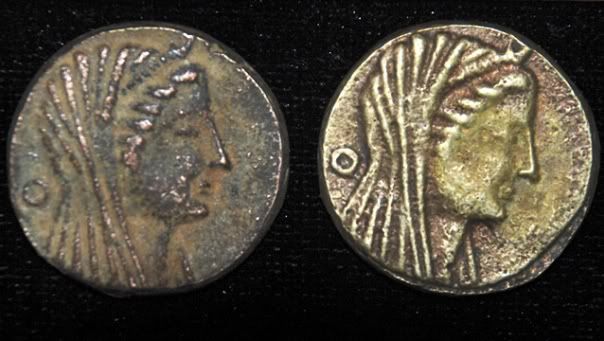
Founded by one of Alexander the Great's generals, the Ptolemaic Dynasty ruled Egypt for some 300 years, fusing Greek and ancient Egyptian cultures.
The coins were found north of Qarun lake in Fayoum Oasis 50 miles southwest of Cairo.
Other artifacts were unearthed in the area included three necklaces made of ostrich egg shell dated back to the 4th millennium B.C. and a pot of kohl eyeliner from the Ottoman Empire.
Associated Press

CAIRO — Archaeologists unearthed 383 bronze coins dating back to King Ptolemy III who ruled Egypt in the 3rd century B.C. and was an ancestor of the famed Cleopatra, Egypt's antiquities authority announced Wednesday.
The statement said one side of the coins were inscribed with hybrid Greek-Egyptian god Amun-Zeus, while the other side showed an eagle and the words Ptolemy and king in Greek.

Founded by one of Alexander the Great's generals, the Ptolemaic Dynasty ruled Egypt for some 300 years, fusing Greek and ancient Egyptian cultures.
The coins were found north of Qarun lake in Fayoum Oasis 50 miles southwest of Cairo.
Other artifacts were unearthed in the area included three necklaces made of ostrich egg shell dated back to the 4th millennium B.C. and a pot of kohl eyeliner from the Ottoman Empire.
Subscribe to:
Posts (Atom)
